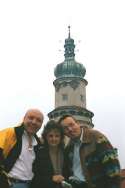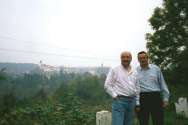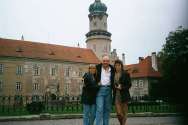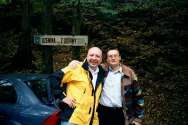
Czech Republic

Czech Republic
      |
|
Nové Město History
Nové Město nad Metují literally stands for New Town on the River Metuje. The historical main square is centered around a rectangle of Renaiisance townhouses and remnants of 16th century fortifications. The original 16th century fort was renovated into a Renaissance chateau. Baroque modifications followed after the Thirty Years War. The last wave of renovations took place in the early 20th century, after the 1908 purchase of the chateau by Jan Bartoň of Dobenin. The Dobenin family commissioned the renowned Czech architect Dusan Jurkovič to create a stately residence with modern amenities. The park landscaping includes French and Italian gardens. Period interiors contain valuable artifacts and art collections of the secession period, decorative elements, Renaissance murals and baroque stuccos. Picturesque baroque sculptures of gnomes, made by Mathias Braun, can be found in the park in front of the chateau. An interesting side note can be said about count Walter of Leslie who acquired the estate during the Thirty Years War. After the defeat of the Czech army in the Battle of Bílá Hora in 1620 estates of those Czech families opposed to the Habsburgs were confiscated and their owners either executed or exiled. Allies of the Habsburgs were first in line to acquire confiscated properties properties. Walter Leslie, Being involved on the side of the Habsburgs, acquired the Nové Město castle in 1624. The Leslie family owned the estate for nearly two centuries until 1802. The Scottish Connection It is important to note the presence of such names at Joneš, Radim's maternal-side family name, in Nové Město even today. An obvious derivation of "Jones", possibly the occurence of this name can be linked to the Leslies' ownership of the estate. It is possible that the Jonese came to the Nové Město area from Aberdeenshire in Scottland. Count Walter Leslie was born in 1606 in Aberdeenshire, the second son of John Leslie of Balquhain (? -1622), and his third wife, Jean, daughter of Sir Alexander Erskine of Gogar. The Leslies of Balquhain were probably the most successful Scottish mercenaries of the 17th century, having acquired by a judicious mixture of military prowess, diplomacy and dynastic marriages a string of castles, palaces and fortresses in Central and Eastern Europe in addition to their original Scottish seats. Fiercely loyal to their Stuart and Habsburg monarchs, Walter Leslie has been described as the most influential Briton on the Continent. In Scotland. centered around their estate at Fetternear, the Leslies of Balquhain were also active in national as well as local affairs. Fetternear and the Leslies were also to play an important role in the re-establishment of the Catholic Church into mainstream Scottish life. Fetternear remained the chief Scottish seat of the Leslies of Balquhain until it was destroyed by fire in 1919. The family were finally forced to sell their ancestral estates of Balquhain and Fetternear in 1932. The Austrian branch of the family parted with their main Czech seat, the Castle of Nové Město early in the 20th century, but retained control of the great Fortress of Ptuj in Slovenia until 1945. The Thun Palace, their town-house in Prague now houses the British Embassy. After thir nearly 1000 year long history that began, according to tradition, after the Battle of Hastings in 1066, they now reside in Austria and Australia. The Bartoňs and 20th Century History of Nové Město In 1908 the Nové Město estate was bought by the Bartoň-Dobenín family. A reconstruction of the Baroque chateau into a 20th century residence began. The family commissioned Dušan Jurkovič, a renowned architect of Slovak origin. The result was a "secession" style (originally a Wienese form of Art Nouveau) mansion and interior carefully incorporating existing Renaiisance and Baroque elements. Beside the Nové Město chateau, in the Nové Město area Jurkovič also built the restaurant and inn in the nearby town of Peklo (Hell), and the Rezek Villa. The 1907 Náhlovský Villa owned by the Kolarsky family in Prague is also the work of Jurkovič. After the communist coup d'etat in 1948, all private ownership of industries and land was gradually eliminated. The Nové Město estate was seized from Bartoňs and the family was forced to emigrate. The family settled in the United States. Following the fall of communism during the Velvet Revolution of 1989, those estates expropriated by the communists in after 1948 were returned to their original owners or to their heirs. The current surviving heir, Joseph Bartoň-Dobenín, together with his wife Elizabeth, was located in Kansas where he has lived since 1958. The entire estate, consisting of the Nové Město chateau, textile factories and other assets in Prague and the nearby city of Náchod, as well as 6,000 acres of farmland and timber, was returned to his family. Joseph Bartoň-Dobenín holds the title of Profesor Emeritus at the College of Business Administration at Kansas State University. Source: The Fetternear research project, The Clan Leslie Society, The Unofficial Clan Leslie Website Adventures in Czech Restitution |
Continue your virtual visit on these websites:
Nové Město official website
History of Nové Město
Chateau
Architect Dušan Jurkovič
Nearby Towns:
Nové Město official website
Photographs (c) 2001 Radim and Lisa Kolarsky
Last updated October 28, 2001